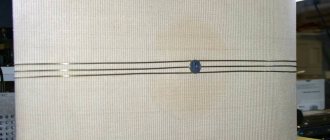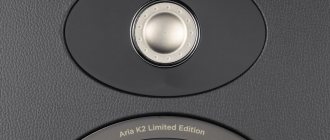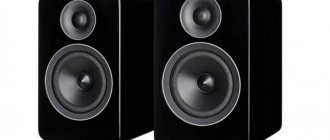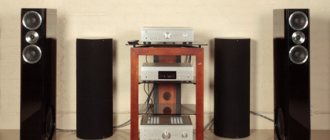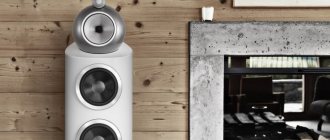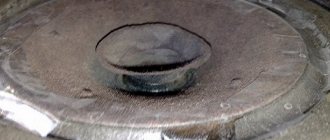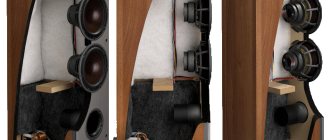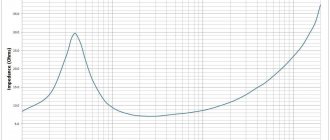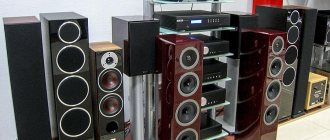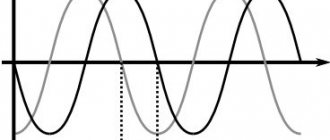DALI Royal - compact speaker systems for small rooms
Expensive, beautiful, respectable
The Danish company DALI offers a very impressive number of speaker systems of different classes, sizes and, accordingly, prices. We have already tested relatively inexpensive speakers from the Blue series and more serious speaker systems from the Suite line. Today we will climb even higher on the price ladder and test the Royal series speakers. It is noteworthy that at a very impressive price, even the front speakers are very compact bookshelf speakers, not to mention the miniature center channel speaker and rear speakers.
The Royal line includes only four speaker models, three of which are included in today's review. Only the floor-mounted Towers “flew by”. More precisely, they were simply not included in the system under test, because we were extremely interested in finding out what could please or disappoint compact bookshelf speakers costing $1000 per pair; you must admit, this is a very high price for bookshelf speakers. No, of course, there are compact speakers that cost many times more, but they already belong to a different class, because only very wealthy music lovers can afford them. So we decided for now to look at the “face” and “vocal data” of the Royal series bookshelf speakers from DALI, especially since the size of the central speaker and rear speakers suggests that the system will be used in a relatively small room, and floor-standing front speakers will be installed somehow I didn’t want to be in one connection with such a small rear and center, because the system must be balanced. Let some of my comrades kick me, who will foam at the mouth and argue that, since there is only one ruler, everything is obviously balanced and there are no problems at all. This may be so, but in practice, if the central speaker differs very significantly in “caliber” from the front pair, harmonizing all this together is not as easy as it seems. Even if all the speakers are from the same line (let’s remember the situation with Boston CR, where, despite fairly high-quality front and rear speakers, the center turned out to be very mediocre, clearly not reaching the level of the other speakers in the line).
All acoustic systems in the Royal line are offered in four (!) possible exterior finishes: natural cherry veneer, white lacquer, black lacquer, blue lacquer. It is quite logical that lacquer finish is priced more expensive than veneer. The buyer of lacquered speakers, in addition to the luxurious lacquer surfaces themselves, receives soft gloves as a gift, in which all manipulations with the speakers should be carried out so as not to leave scratches and fingerprints on the lacquered surface. Of course, we did not neglect the DALI offer and grabbed the speakers only with gloves. In addition, gloves clearly hint that this is a solid item that requires special handling. In some way, gloves are part of the “image halo” that is invariably created around expensive and prestigious things, which can also be called the Royal series speakers. If anyone doesn’t know, Royal is translated as “royal”.
DALI Royal Scepter
"Royal scepter" (from English). This model came to us for testing in a white lacquer “robe”. Well, what can we say - it looks very beautiful, even mesmerizing. Of course, not a single joint of the body panels is visible from the outside - the varnish neatly covers the entire surface of each wall. Even the bottom of the column is covered with it.
As for the design, the Royal Scepter is a completely traditional two-way bass reflex speaker system. The bass reflex port is located on the rear panel of the speaker.
The terminal block allows for both traditional (two-cable) and four-cable connections using the bi-wiring scheme. Of course, the ability to use banana connectors is present here.
The speaker cabinet is made from thick MDF boards (the walls and rear panel are 25 mm thick, the front panel is 20 mm thick), so no internal spacers are simply needed, because taking into account the size of each MDF panel, the resistance to resonances will be very high: when tapped The body barely responds to the knuckles. A rather large piece of padding polyester acts as a sound absorber, occupying almost the entire internal volume. During photography, the absorber was removed from the housing.
The DALI speaker is responsible for reproducing low and mid frequencies. The speaker is based on a polymer cone holder, which, through a soft rubber suspension, holds a 125 mm impregnated paper cone. The diffuser material is quite similar to that used in the Suite line. It is curious that there is no magnetic shielding, however, real interference on display devices based on CRTs can be seen only when the speakers are located at a distance of less than 40-50 cm, which in most cases allows you not to think at all about the presence or absence of shielding of the LF magnetic system /midrange dynamics.
But the tweeter is very reminiscent of the D20TD model from Vifa. Unfortunately, for technical reasons, our photo of the HF driver was spoiled, so we cannot say unequivocally that the Scepter and Menuet II models have a Vifa HF speaker installed... But they are very similar...
| DALI Royal Scepter | |
| Technical characteristics (passport) | |
| Acoustic design | Bass reflex (port on the rear panel) |
| Recommended amplifier power | 25 - 150 Watt |
| frequency range | 60 Hz - 25 kHz (+/- 3 dB) |
| Sensitivity | 88 dB |
| Resistance | 4 ohm |
| Filter cutoff frequency | 3.6 kHz |
| Dynamic emitters | LF/MF: cone diffuser (125 mm in diameter) made of impregnated paper |
| HF: dome diffuser (19 mm in diameter) made of fabric | |
| Terminals | 2 pairs of high quality banana jack screw terminals |
| Magnetic shielding | No |
| Are common | |
| Housing material | MDF. Natural cherry veneer or piano varnish. |
| Dimensions (H×W×D) | 307×186×220 mm |
| Weight without packaging (pcs.) | 4.9 kg |
| Price* per pair | $985 (cherry veneer) $1120 (white polish, black polish, blue polish) |
* recommended retail price of the official distributor in Russia.
Measurement results
Judging by the frequency response, the tonal balance of the speaker will be quite neutral, since there are no global distortions in the graph. Some irregularities in the lower middle area will of course slightly affect the sound, but it will only be perceived as the sound character of this model. The distortion level drops below 1% after 150 Hz and does not go beyond this level until the highest frequencies. At low frequencies, distortion increases to several percent.
Measurements at an angle of 45° in the horizontal plane demonstrated the ability of the speakers to correctly emit sound at a fairly significant angle of deviation from the axis of the speakers, which means that it is not at all necessary to strictly orient the speakers toward you, and the zone of stable stereo effect will be quite wide.
DALI Royal Menuet II
These compact, but very harmonious-looking speakers are finished with natural cherry veneer, and an additional varnish coating is visible on top of the veneer, giving the wooden surface additional shine. The color of the speakers can even be called a little flashy, since the rather bright red shade of the veneer almost instantly attracts attention. Maybe that's what they were counting on? It’s probably not worth saying that we not only had no complaints about the quality of finishing. On the contrary, the veneer of DALI Royal Menuet II is akin to the finishing of luxury furniture. As you already understand, the appearance of the Royal series speakers is a very significant trump card, emphasizing the special status of these speaker systems. With all their sophisticated and even somewhat prim appearance, the speakers demonstrate that they belong in the respectable home of a wealthy person.
And if it is very difficult to judge the size of the speakers from the first photo, because due to the relatively small diffuser of the HF driver (only 19 mm, like the Scepter model), which makes the entire speaker look somewhat larger than it actually is, then with direct Comparing this speaker system with an ordinary CD, it immediately becomes clear that the dimensions of the Menuet II are really small.
The rear panel of the Menuet II demonstrates the class and quality of the product. First, of course, is the quality of the finish. Take a look at how accurately the veneer sheets are joined. Even the pattern of the wood texture was chosen. Secondly, it is noticeable that the body is assembled from very thick plates - the same ones from which the very strong body of the Scepter is made. And, thirdly, a terminal block that allows you to use both a four-cable connection and banana connectors if desired. Although there is nothing particularly surprising here - we expected something like this from compact speakers costing eight hundred dollars. So it's okay.
The interior design of the Menuet II is very reminiscent of the Scepter. True, the padding polyester sound absorber no longer fills almost the entire volume of the case, but there is still a lot of it. Due to the use of thick hull walls, internal bulkheads were also not needed. When you tap on the speaker body, you can only hear a very quiet “response”, which indirectly indicates a strong and vibration-resistant case. However, this was obvious even without tapping.
The 19mm fabric dome tweeter used in the Menuet II is the same as we saw in the Scepter, but the woofer/midrange driver not only has a different diameter (only 10 cm), but is also made of a different material - made of polymer. Judging by the markings, the speaker is definitely related to Vifa, a well-known Danish manufacturer of speaker drivers. It is quite possible that these speakers were developed specifically for DALI by Vifa as an OEM product, because the manufacturer itself is not indicated on the speaker itself - only the model index and country of manufacture. And DALI, at least, always puts its logo on the driver.
| DALI Royal Menuet II | |
| Technical characteristics (passport) | |
| Acoustic design | bass reflex (port on the rear panel) |
| Recommended amplifier power | 25 - 100 Watt |
| frequency range | 70 Hz - 25 kHz (+/- 3 dB) |
| Sensitivity | 86 dB |
| Resistance | 4 ohm |
| Filter cutoff frequency | 4.2 kHz |
| Dynamic emitters | LF/MF: cone diffuser (100 mm in diameter) made of impregnated paper |
| HF: dome diffuser (25 mm in diameter) made of fabric | |
| Terminals | 2 pairs of banana jack screw terminals |
| Magnetic shielding | No |
| Are common | |
| Housing material | MDF. Natural cherry veneer or piano varnish. |
| Dimensions (H×W×D) | 257×156×185 mm |
| Weight without packaging (pcs.) | 4 kg |
| Price per pair | $785 (cherry veneer) $920 (white polish, black polish, blue polish) |
Measurement results
The frequency response of the Menuet II has slightly more noticeable irregularities in the upper mids and high frequencies, which can make some changes in the tonal balance of the speaker, relative to the Scepter model, although not very significant.
The situation with the nature of distortion and the ability to reproduce sound at an angle of 45° in the horizontal plane of the Menuet II model is very similar to the results shown by Scepter.
DALI Royal Vocal
Two-way center channel speaker. This speaker can rightfully be considered miniature - take a look at the photo where a regular CD is installed on the speaker. However, even with its dimensions, the speaker does not look like a toy at all. It's still a solid and expensive looking thing, just very small
The speakers are arranged according to a traditional symmetrical design, which allows for a symmetrical distribution of sound waves in the horizontal plane, relative to the axis of the tweeter.
Since the Royal Vocal's cabinet is made from thinner MDF than the previous two models, the developers have seen fit to equip the speaker with two internal braces. The synthetic winterizer still acts as an absorber.
But the size of the diffusers of the bass/midrange speakers is frankly touching on the one hand and alarming on the other: only 65 mm! In some speakers, even mid-frequency drivers have a larger cone diameter, but here they are entrusted with the responsible mission of reproducing not only mid-frequencies, but also bass. That is, Royal Vocal is, in theory, a completely full-fledged center channel speaker, but when looking at the compact size and tiny LF/MF speakers, I recall a phrase from one famous film by L. Gaidai: “I am tormented by vague doubts...”. Yes, there really are doubts, and not even entirely vague ones. Miniaturization, of course, can be good, but such small speakers usually do not have the proper dynamic range and are often unable to reproduce the correct tonal balance, not to mention the physical inability to produce even the slightest bit of serious bass. But that's "usual". We still have to find out how the speaker will behave as part of a home theater complex.
I wouldn't say that if it weren't for the price of the DALI Royal Vocal model (~$500). And for $500, a speaker should not only look stylish, but also sound, and sound good. To be fair, it should be said that usually the description of models is done several days before the start of listening and measurements, so now I am describing the speakers without having either frequency response graphs or listening impressions. Hence the reasoning about the ability or inability of Royal Vocal to produce the full-fledged sound that should be expected from this not the cheapest speaker.
The high-frequency driver has a 25 mm fabric dome. The speaker is manufactured by Vifa. This is model D24NC. However, it is not so important who made the speaker, but what is important is how this speaker sounds (in conjunction with other speaker drivers, of course).
| DALI Royal Vocal | |
| Technical characteristics (passport) | |
| Acoustic design | Bass reflex (dual port on the front panel) |
| Recommended amplifier power | 30 - 120 Watt |
| frequency range | 74 Hz - 25 kHz (+/- 3 dB) |
| Sensitivity | 89 dB |
| Resistance | 4 ohm |
| Filter cutoff frequency | 3.2 kHz |
| Dynamic emitters | LF/MF x 2: cone diffuser (65 mm in diameter) made of impregnated paper |
| HF: Dome diffuser (25 mm in diameter) made of fabric | |
| Terminals | 1 pair of banana jack screw terminals |
| Magnetic shielding | Yes |
| Are common | |
| Housing material | MDF. Natural cherry veneer or piano varnish. |
| Dimensions (H×W×D) | 118×366×198 mm |
| Weight without packaging (pcs.) | 4.5 kg |
| Price for one | $492 (cherry veneer) $544 (white polish, black polish, blue polish) |
Measurement results
It would be surprising if such compact speakers showed almost a “line” on the frequency response graph, but noticeable unevenness is observed only in the lower mids and bass - a pretty good result for a small-sized speaker, although quite expensive.
The distortion level is also low and does not exceed 1% over most of the range.
Sound in music
Most of the listening was carried out on the Scepter model, and we spent a little less time on the Menuet II, since the sound of the Menuet II, as it turned out, was not very different from its larger “sister”. At least the tonal balance and basic “habits” of these two models are almost the same. Menuet II is only inferior in dynamics and, of course, has less deep and assertive bass. So the description of the Scepter's sound can be applied almost equally to the Menuet II, keeping in mind the few differences that keep the speakers from sounding exactly the same.
As usual, we started listening with our test selection of acoustic music. These are compositions in the style of jazz, fusion, ethnic music and blues. When playing various compositions, we unanimously noted the excellent separation of instruments - the sound did not “fall into mush” even on rather complex material, which made it possible to hear the parts of all instruments even during the tutti of a large group of musicians. This situation was maintained at various volumes, up to a volume “above average” (that is, almost on the verge of comfortable perception). At high volumes, the sound sounded as if it had been mixed with a blender, but this is not so important, since hardly anyone will listen at such a volume. In general, the speakers “love” medium volume. This means we can talk about full sound recording of a room with an area of up to 20 m². Although, of course, there won’t be even more or less serious bass in such compact bookshelf speakers, the tonal balance can still be called “correct” and almost “monitor-like”. The high frequencies sounded somewhat unusual: everything seemed to be in place, but somehow it was perceived in an unusual way. However, this is only a feature of the sound nature of the speakers, since the recognition of timbres does not suffer at all from this. We had no complaints about the detail, nor about the attack. And everything seems to be fine, the sound is quite “expensive” and comfortable... but it doesn’t grab your soul.
The situation changed almost radically when we started listening to our selection of classics. Here the speakers demonstrated their ability to quite accurately shape space, and the sense of stage depth was quite strong. The classics sounded comfortable and even emotional. One can only complain about the lack of deep and dense bass, the lack of which in classical music is perceived as a reduction in the scale of what is happening, and the dynamic range could be wider.
Now, it’s probably worth saying that we “listen with passion” for only one simple reason: if small “shelf speakers” cost $1000, they should “perform” and not reproduce, and therefore it’s not a sin to conduct a more detailed “debriefing” , which is what we do.
The speakers are especially good at recording chamber music and emotional recordings of symphonic music. For example, we listened to Rachmaninov’s second concerto with outright pleasure, despite the lack of bass, which still slightly prevented us from completely switching to the music. Otherwise, the speakers demonstrated a rather “adult” sound.
The speakers coped with the reproduction of rock and pop music with a “C”, since in this case what is needed is not a “scene” and elaboration of nuances, but dense bass, a sense of involvement and rhythm (the so-called “drive”). It goes without saying that such a compact speaker did not have enough of all this. And the point here is not precisely these speakers, but the class of compact “bookstand speakers” itself - well, all these little ones are not capable of pleasing the ears of an avid lover of rock and blues - larger and more powerful speakers are needed here.
So we can say that the DALI Royal Scepter and DALI Royal Menuet II are most comfortable when reproducing classics and light melodic acoustic music.
Sound in the theater
It's funny, but the tiny central speaker surprised us a little. Yes, there was no significant bass there at all, and the sound dynamics were not all right (as if the sound had been passed through a compressor/limiter - this is a feature of most miniature speakers), but the tonal balance was surprisingly comfortable. and even almost “correct”. The center speaker matches the front speakers quite well, despite our concerns. However, the situation should not be overestimated: today’s kit is capable of creating full-fledged theatrical sound only in a relatively small room, with an area of about 15 m². The limiter is the central speaker, which at high volumes begins to sound less comfortable – it starts to “scream”. But in a relatively small room the sound will be quite good, adjusted for the size of the speakers, and therefore the restrictions imposed by these sizes. But the attack is quite good - all the biting sounds, like the clinking of glass or a gunshot, sound quite “juicy”.
Conclusion
Impressions from DALI Royal were twofold. On the one hand, with such dimensions the speakers sound really good, and the luxurious finish is unlikely to leave anyone indifferent. On the other hand, the sound is not very impressive, given the hefty price. Definitely, DALI Royal is designed for expensive interiors of small rooms. For those who are willing to overpay for luxurious finishes and the image of the speakers. Well, if you evaluate these speakers only from the point of view of sound, then the price seems unreasonably high...
We recommend using the kit in rooms with an area of 10 to 15 m².
pros
- chic appearance;
- well-developed sound with correct tonal balance and good separation of instruments.
- compact dimensions;
- speakers have a special aura inherent in elite things.
Minuses
- very high price considering the sound quality.
We thank A&T Trade for providing DALI Royal speaker systems for testing
Bookshelf acoustics DALI Mentor Menuet, review. AudioVideo Salon magazine, November 2010
Everything in Mentor Menuet is at the highest level. This applies to finishing, filling, and characteristics. Small DALIs have an unusually wide range and reproduce bass at frequencies that not every floor-standing system can handle.
Save and read later -
Here is the most intriguing new product among mini-monitors - two-way DALI Mentor Menuet. They embody all the technical innovations of the high-end Mentor line, and this is immediately visible. The woofer cone is made of expensive long-fiber cellulose - a material with the best resonant characteristics. The tweeter with a 28mm silk dome is the same as in older DALI models. The mass of their moving system is about a third less than that of other soft-dome emitters. The speaker cabinets are made of solid wood and equipped with a bass reflex, and the port located at the rear is installed at an angle to the horizontal axis (this is less sensitive to internal box resonances). We also note the high-quality gold-plated terminals.
Everything in Mentor Menuet is at the highest level. This applies to the finishing (three options, among them there is a very beautiful matte black varnish coating), the filling, and the characteristics. Judging by the data, small DALIs have an unusually wide range and reproduce bass at frequencies that not every floor-standing system can handle. At first we didn’t believe it ourselves...
From the first minutes of listening, it became clear why these monitors cost so much. They are the only ones in our review that can clearly, clearly and with sufficient force reproduce a large orchestral drum! Bass guitar and double bass are not a problem for them - they convey their sound dynamically, sharply, with a pleasant drive. But the ability to produce a “grown-up” low end is not the most valuable quality of Mentor Menuet. I was captivated by both the linearity in the midrange and the extraordinary tonal neutrality at the top. If the systems are placed at a distance of at least a meter (strictly), then a complete illusion of expensive studio monitors with a calibrated frequency response arises. All harmonic nuances, microdynamic and spatial, are in full view.
The only criticism is that the sound stage is somewhat compressed at the edges. But this problem should no longer be associated with the speakers, but with the desktop installation. As soon as you raise the Mentor Menuet above the reflective surface by 10 - 15 centimeters, the entire space receives the proper volume, and the images become tangibly clear. At the same time, the rhythmic pattern improves, the sound becomes faster and cleaner - the quantity of bass turns into quality.
| PLEASED | The widest range and most realistic bass dynamics. Very linear mid and high register. High harmonic and spatial resolution. | |
| DISAPPOINTED | The distance is no closer than a meter. All the advantages of a desktop installation will only appear with stands 10 - 15 cm high, and finding such ones is problematic. |
| Dependence of module Z on frequency DALI Mentor Menuet As usual with DALI, the impedance does not have sharp peaks and dips, respectively, and the phase response is also smooth throughout the entire frequency range. And with a small reactive component of the load, as is known, sharp signal edges are transmitted better. The bass reflex is set to 62 Hz, the filters have phase equalizing sections. The systems are 4-ohm, and in the HF range their resistance ranges from 7 to 10 ohms, so there will be no problems with choosing an amplifier. |
| Frequency response of DALI Mentor Menuet An excellent result for bookshelfs of this size. Starting from 120 Hz, the frequency response is absolutely linear, and even the rise of the tweeter at 16 kHz is very small. DALI engineers make it specially so that even in a room with upholstered furniture the speakers sound linear. And the dispersion, as always, is wide - with a deviation from the axis of 30 degrees. the characteristic is still smooth, and even at 50 degrees. shows a decline only after 6 kHz. This radiation pattern guarantees a wide stereo effect area and clear localization of sources. But there is also a minus - noticeable overtones in the bass reflex tube at 1500 Hz, so if there is a subwoofer in the system, it is better to muffle the port. Sensitivity is about 86 dB; accordingly, an amplifier will need from 80 W per channel. |
Prepared based on materials from the AudioVideo Salon magazine, November 2010
www.salonav.com This review was read 3,789 times
